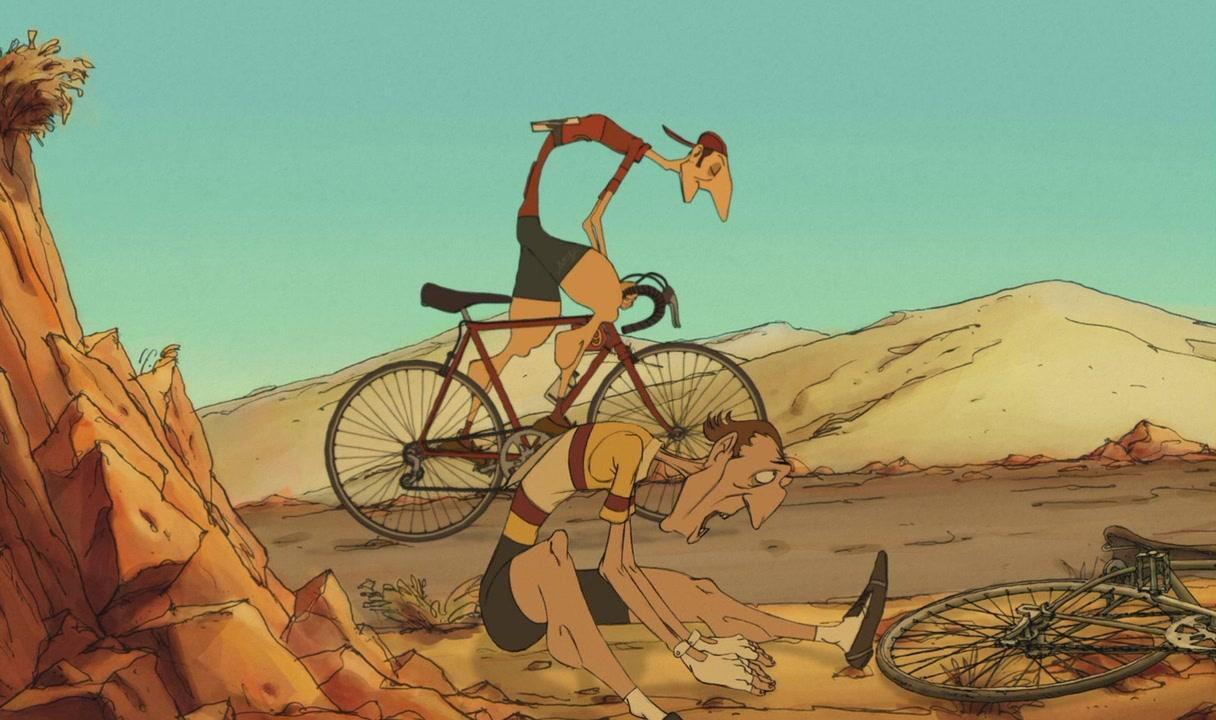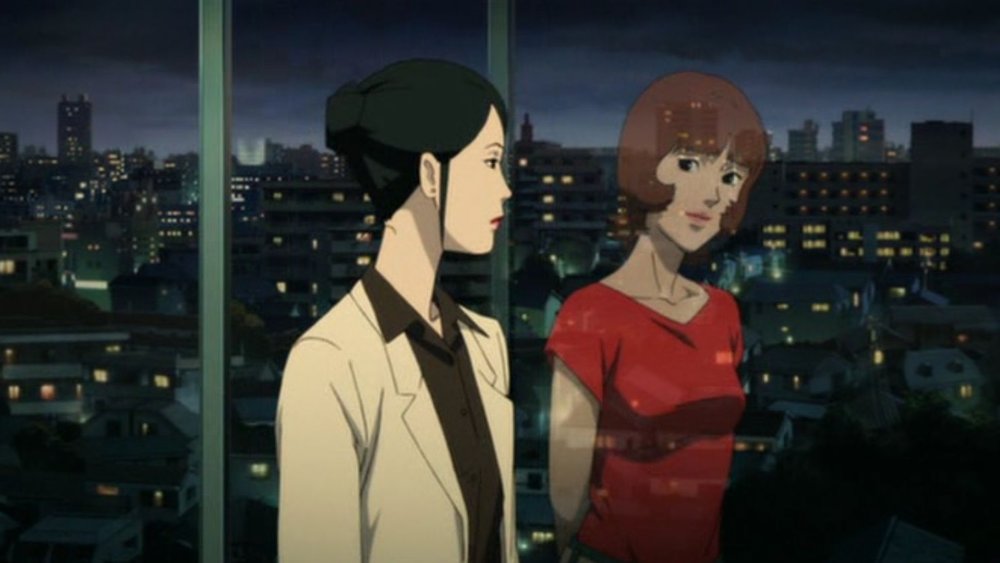Music - http://www.thedarkpiano.com/dark-orchestra-music
Saturday 24 February 2018
Thursday 22 February 2018
Monday 19 February 2018
Friday 16 February 2018
Thursday 15 February 2018
Film Review | Belleville Rendez-Vouz
Belleville Rendez-Vouz (2003) is a French film directed by Sylvain Chomet. The film Belleville Rendez-Vous is also known under the name The Triplets of Belleville and tells the story of a boy who wants to take part in the Tour de France and is living with his grandma.
 |
| Fig 1, Movie Poster |
The film begins with a scene of the triplets mid performance. This is all done with rubber-hose animation as the style in reference to the animation used in the time period portrayed. After the opening scene the film continues in a more modern animation style so as to represent the way the show they were watching came from a past time.
 |
| Fig 2, The triplets in Rubber-Hose style |
 |
| Fig 3, The cyclists. |
During the film the son gets kidnapped from the race and his grandmother then sets out to save him. This leads the grandmother 'to Belleville, a Manhattan-like dream city populated by obese hamburger eaters, cretinous Boy Scouts, and a diminutive red-nosed French mafia chieftain.' (Scott, 2003). This is the start of a 'world of selfishness, cruelty, corruption and futility -- but it's not serious about this world and it doesn't want to attack it or improve upon it. It simply wants to sweep us up in its dark comic vision.' (Ebert, 2003). Though the film is including a kidnapping that leads to a character being caught in a torture like gambling ring it never loses it's sense of fun.
- Dawson, T, (2003), Belleville Rendez-Vouz, http://www.bbc.co.uk/films/2003/08/06/belleville_rendezvous_2003_review.shtml (Accessed on: 15/02/18)
- Ebert, R, (2003), The Triplets of Belleville, https://www.rogerebert.com/reviews/the-triplets-of-belleville-2003 (Accessed on: 15/02/18)
- Scott, A, (2003), Nostalgia For a Land That Twirls In Dreams:
http://www.nytimes.com/movie/review?res=9E04E1DA1F3BF935A15752C1A9659C8B63 (Accessed on: 15/02/18)
Illustration List:
Bibliography:
- Dawson, T, (2003), Belleville Rendez-Vouz, http://www.bbc.co.uk/films/2003/08/06/belleville_rendezvous_2003_review.shtml (Accessed on: 15/02/18)
- Ebert, R, (2003), The Triplets of Belleville, https://www.rogerebert.com/reviews/the-triplets-of-belleville-2003 (Accessed on: 15/02/18)
- Scott, A, (2003), Nostalgia For a Land That Twirls In Dreams:
http://www.nytimes.com/movie/review?res=9E04E1DA1F3BF935A15752C1A9659C8B63 (Accessed on: 15/02/18)
Illustration List:
- Fig 1, Movie Poster: https://www.amazon.co.uk/Belleville-Rendez-vous-DVD-Mich%C3%A8le-Caucheteux/dp/B015ZGAT7C
- Fig 2, The triplets in Rubber-Hose Style: http://www.allocine.fr/film/fichefilm-44206/photos/detail/?cmediafile=18354168
- Fig 3, The cyclists: https://www.silent-frame.com/articles/2003-belleville-rendezvous-sylvain-chomet
- Fig 2, The triplets in Rubber-Hose Style: http://www.allocine.fr/film/fichefilm-44206/photos/detail/?cmediafile=18354168
- Fig 3, The cyclists: https://www.silent-frame.com/articles/2003-belleville-rendezvous-sylvain-chomet
Tuesday 6 February 2018
Film Review | Paprika
Paprika (2006) is a Japanese film directed by Satoshi Kon. It was based on Yasutaka Tsutsui's novel from 1993.
 |
| Fig. 1, Movie Poster |
Two of the main characters, Atsuki Chiba and Paprika, are slowly shown to be connected until it's revealed that they are the same person. Paprika is thus shown to be Atsuki's projection of herself on the dreams. This is played with later in the film as we see both Atsuki and Paprika interacting with each other and other people within the final dream.
One of the reasons the film was created using animation over live-action with CGI is because some scenes would be easier to show through animation. This is in part due to expense as well as technological limitations. One scene that demonstrates this is when Atsuki is revealed inside Paprika as while the scene may have been possible in CGI it would have been more challenging and expensive to do.
The film warps and shift the images seen frequently throughout the film. This leads to fluid transitions between being awake and dreaming as well as showing the slow way fantasies can be found more interesting by people than the reality they live in. During one dream in particular, a parade of inanimate objects are shown. In an interview Satoshi Kon said that 'for viewers to identify with this dream, I chose a parade which makes one think automatically of other common dreams and unconscious states. There are very old characters like objects that are discarded by people today or religious symbols that people have forgotten.'(Pais, 2006). This dream formed a shared dream in which the dreamers are dragged into the dream and lose all sense of themselves outside of the dream world. The mass of objects in the dream 'works to one of the film’s themes, namely that our fantasies, including those opened up by the Internet, are pulling us away from the material world and, perhaps, more dangerously from one another.' (Dargis, 2007). This is further shown in how one of the entrances to the dream world is through a virtual bar one of the main characters logs into. He gets brought into the bar as if he were truly there and interacts with everything as if it were real.
Reality in the film slowly declines as the film progresses. This begins when Chiba hops over a fence at an amusement park only for it to warp and reveal she was about to hop over a balcony instead (shown in Figure 4). This is the first instance the audience encounters that shows reality shifting in the same way dreams would. This is in the film said to be due tot he amount of time spend within the DC Mini and that the longer spent in there the easier it is to slip into a dream without realising even when awake.
Bibliography:
- Dargis, N, (2007), [Online], http://www.nytimes.com/2007/05/25/movies/25papr.html (Accessed on: 05/02/18)
- Pais, J, (2006), [Online], http://screenanarchy.com/2006/10/paprika-interview-with-satoshi-kon.html (Accessed on 05/02/18)
Illustration List:
- Figure 1, Movie Poster, http://www.imdb.com/title/tt0851578/
- Figure 2, Reflections, http://www.talkfilmsociety.com/columns/fresh-eyes-paprika-2006
- Figure 3, Paprika is Atsuka, http://www.interrogatingideologywithachainsaw.com/2014/06/paprika-2006.html
 |
| Figure 2, Refleection. |
 |
| Figure 3, Paprika is Atsuka |
 |
| Figure 4, Losing Reality. |
Bibliography:
- Dargis, N, (2007), [Online], http://www.nytimes.com/2007/05/25/movies/25papr.html (Accessed on: 05/02/18)
- Pais, J, (2006), [Online], http://screenanarchy.com/2006/10/paprika-interview-with-satoshi-kon.html (Accessed on 05/02/18)
Illustration List:
- Figure 1, Movie Poster, http://www.imdb.com/title/tt0851578/
- Figure 2, Reflections, http://www.talkfilmsociety.com/columns/fresh-eyes-paprika-2006
- Figure 3, Paprika is Atsuka, http://www.interrogatingideologywithachainsaw.com/2014/06/paprika-2006.html
- Figure 4, Losing Reality, https://cinemaoftheabstract.blogspot.co.uk/2016/06/paprika-2006.html
Saturday 3 February 2018
Film Review | Mary and Max
Mary and Max (2009) is an Australian film written and directed by Adam Elliot. The film follows the story of a girl named Mary and a man named Max. The film was created using claymation and explores themes of loneliness as well as mental health.
The use of claymation allowed for a distinct line to be drawn in the colours used throughout the film. New York, and by extension Max, is depicted in black and white while Australia and Mary are seen in browns. The only exception to this is the colour red which can be seen in both places, primarily through the gifts and letters the characters send to each other. This allowed the use of 'red as a device to make all those little objects that Mary and Max send each other more potent, more significant.' (Buckmaster, 2009). Examples of this can be seen in Figures 2 and 3. Figure 2 shows Max and his red pompom while figure 3 shows Mary and her red hair clip and ring.
The film discusses themes such as loneliness and mental illness. This is through a few different ways. One way is that there is a focus on Mary not having friends and thus being lonely, this is furthered when the audience is aware of her father remaining in his garage without talking to her when he isn't working and her mother being an alcoholic. This leaves Mary lonely as she has nobody she can talk to both at home and at school. Loneliness is also shown through Max as shown through his lack of friends and his having an imaginary friend. Another theme explored through the film is mental illness. This is seen in various ways throughout the film such as Max's Asperger's and Mary's later depression. Throughout the film it's shown that 'Everyone in the film is damaged; a few are suicidal and don't make it, so there's a sense of life's traumas.' (Byrnes, 2009). This allows for the audience to see characters that aren't perfect and haven't got perfect lives, they're more mundane and have troubles that anyone could face.
Bibliography:
- Buckmaster, L (2009), Interview with Adam Elliot, writer/director/designer of Mary and Max [Online] https://blogs.crikey.com.au/cinetology/2009/04/10/q-a-with-mary-and-max-writerdirectordesigner-adam-elliot/ (Accessed: 02/02/18)
- Byrnes, P, (2009), Review - Mary And Max, http://www.smh.com.au/news/entertainment/film/film-reviews/mary-and-max/2009/04/09/1239222976896.html (Accessed on: 03/02/18)
Illustration List:
- Figure 1, Movie Poster, http://mstamp176.blogspot.co.uk/2016/02/review-mary-and-max.html
- Figure 2, Max, https://nwfilm.org/films/mary-and-max/
- Figure 3, Mary, http://www.imdb.com/title/tt0978762/mediaviewer/rm1527398144
 |
| Fig 1, Movie Poster |
The film first introduces the audience to Mary, a lonely girl whose parents ignore her for the most part and who is bullied at school. She lives in Australia and wants a friend so to achieve that ends up sending a letter to a random name in the phone book, thus Max is introduced. Max is a 44 year old man living in New York, he also is lonely and lacks friends and so when he receives Mary's letter he replies. This begins an odd friendship between the two.
 |
| Fig. 2, Max |
 |
| Fig. 3, Mary. |
Bibliography:
- Buckmaster, L (2009), Interview with Adam Elliot, writer/director/designer of Mary and Max [Online] https://blogs.crikey.com.au/cinetology/2009/04/10/q-a-with-mary-and-max-writerdirectordesigner-adam-elliot/ (Accessed: 02/02/18)
- Byrnes, P, (2009), Review - Mary And Max, http://www.smh.com.au/news/entertainment/film/film-reviews/mary-and-max/2009/04/09/1239222976896.html (Accessed on: 03/02/18)
Illustration List:
- Figure 1, Movie Poster, http://mstamp176.blogspot.co.uk/2016/02/review-mary-and-max.html
- Figure 2, Max, https://nwfilm.org/films/mary-and-max/
- Figure 3, Mary, http://www.imdb.com/title/tt0978762/mediaviewer/rm1527398144
Subscribe to:
Posts (Atom)








